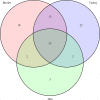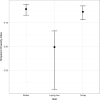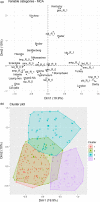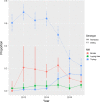Identifying emerging trends in antimicrobial resistance using Salmonella surveillance data in poultry in Spain
- PMID: 31484211
- PMCID: PMC7028142
- DOI: 10.1111/tbed.13346
Identifying emerging trends in antimicrobial resistance using Salmonella surveillance data in poultry in Spain
Abstract
Despite of controls and preventive measures implemented along the food chain, infection with non-typhoidal Salmonella (NTS) remains one of the major causes of foodborne disease worldwide. Poultry is considered one of the major sources of NTS. This has led to the implementation of monitoring and control programmes in many countries (including Spain) to ensure that in poultry flocks infection is kept to a minimum and to allow the identification and monitoring of circulating NTS strains and their antimicrobial resistance (AMR) phenotypes. Here, we investigated the information from the monitoring programme for AMR in Salmonella from poultry in Spain in 2011-2017 to assess the diversity in phenotypic resistance and to evaluate the programme's ability to detect multi-resistance patterns and emerging strains in the animal reservoir. Data on serotype and AMR to nine antimicrobials obtained from 3,047 NTS isolates from laying hens (n = 1,060), broiler (n = 765) and turkey (n = 1,222) recovered during controls performed by the official veterinary services and food business operators were analysed using univariate and multivariate methods in order to describe host and serotype-specific profiles. Diversity and prevalence of phenotypic resistance to all but one of the antimicrobials (colistin) were higher in NTS from broiler and turkey compared with laying hen isolates. Certain combinations of serotype and AMR pattern (resistotype) were particularly linked with certain hosts (e.g. susceptible Enteritidis with laying hens, multi-drug resistant (MDR) Derby in turkey, MDR Kentucky in turkey and broiler). The widespread presence of certain serotype-resistotype combinations in certain hosts/years suggested the possible expansion of MDR strains in the animal reservoir. This study demonstrates the usefulness of the analysis of data from monitoring programmes at the isolate level to detect emerging threats and suggests aspects that should be subjected to further research to identify the forces driving the expansion/dominance of certain strains in the food chain.
Keywords: Non-typhoidal Salmonella; antimicrobial resistance; foodborne; monitoring; poultry; serotype Kentucky.
© 2020 The Authors. Transboundary and Emerging Diseases published by Blackwell Verlag GmbH.
Conflict of interest statement
The authors declare no conflicts of interests in relation to this work.
Figures





Similar articles
-
Prevalence and antimicrobial resistance of Salmonella serovars isolated from poultry in Ghana.Epidemiol Infect. 2016 Nov;144(15):3288-3299. doi: 10.1017/S0950268816001126. Epub 2016 Jun 23. Epidemiol Infect. 2016. PMID: 27334298 Free PMC article.
-
Prevalence, antimicrobial susceptibility and risk factors associated with non-typhoidal Salmonella on Ugandan layer hen farms.BMC Vet Res. 2017 Nov 29;13(1):365. doi: 10.1186/s12917-017-1291-1. BMC Vet Res. 2017. PMID: 29187195 Free PMC article.
-
Monitoring antimicrobial resistance in Salmonella enterica serovar Infantis isolates of poultry, livestock, and humans across the United States, 2013-2020.Int J Food Microbiol. 2025 Mar 16;432:111090. doi: 10.1016/j.ijfoodmicro.2025.111090. Epub 2025 Jan 30. Int J Food Microbiol. 2025. PMID: 39919607
-
Integrating One Health strategy to mitigate antibiotic resistance in Salmonella: insights from poultry isolates in Southeast Asia.Trop Biomed. 2025 Mar 1;42(1):27-35. doi: 10.47665/tb.42.1.005. Trop Biomed. 2025. PMID: 40163400 Review.
-
Population dynamics and antimicrobial resistance of the most prevalent poultry-associated Salmonella serotypes.Poult Sci. 2017 Mar 1;96(3):687-702. doi: 10.3382/ps/pew342. Poult Sci. 2017. PMID: 27665007 Review.
Cited by
-
Serotype Is Associated With High Rate of Colistin Resistance Among Clinical Isolates of Salmonella.Front Microbiol. 2020 Dec 18;11:592146. doi: 10.3389/fmicb.2020.592146. eCollection 2020. Front Microbiol. 2020. PMID: 33391208 Free PMC article.
-
Reservoirs of antimicrobial resistance in the context of One Health.Curr Opin Microbiol. 2023 Jun;73:102291. doi: 10.1016/j.mib.2023.102291. Epub 2023 Mar 11. Curr Opin Microbiol. 2023. PMID: 36913905 Free PMC article. Review.
-
Monitoring of Antimicrobial Resistance to Aminoglycosides and Macrolides in Campylobacter coli and Campylobacter jejuni From Healthy Livestock in Spain (2002-2018).Front Microbiol. 2021 Jul 2;12:689262. doi: 10.3389/fmicb.2021.689262. eCollection 2021. Front Microbiol. 2021. PMID: 34276619 Free PMC article.
-
Genomic characterization of multidrug-resistant Salmonella serovar Kentucky ST198 isolated in poultry flocks in Spain (2011-2017).Microb Genom. 2022 Mar;8(3):000773. doi: 10.1099/mgen.0.000773. Microb Genom. 2022. PMID: 35259085 Free PMC article.
-
Patterns of antimicrobial resistance in Salmonella isolates from fattening pigs in Spain.BMC Vet Res. 2022 Sep 3;18(1):333. doi: 10.1186/s12917-022-03377-3. BMC Vet Res. 2022. PMID: 36057710 Free PMC article.
References
-
- Aerts, M. , & Jaspers, S. (2012). Analysis of isolate based data on antimicrobial resistance collected from volunteer Member States for the year 2010. Supporting Publications: EN‐308, Retrieved from: http://www.efsa.europa.eu/publications
-
- Anon (2003). Regulation (EC) No 2160/2003 of the European Parliament and of the Council. Official Journal of the European Union, L325, 1.
-
- Anon (2010). Commission regulation 200/2010 implementing Regulation (EC) 2160/2003 of the European Parliament and of the Council as regards a Union target for the reduction of the prevalence of Salmonella serotypes in adult breeding flocks of Gallus gallus . Official Journal of the European Union, L61, 9.
MeSH terms
Substances
Grants and funding
LinkOut - more resources
Full Text Sources
Medical

